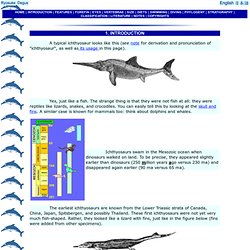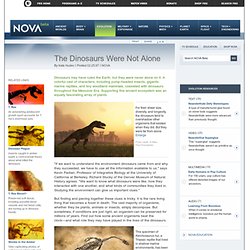

Evolutionary Relationships of Archosaurs. Chinese dinosaurs. Ichthyosaur. 1.

INTRODUCTION A typical ichthyosaur looks like this (see note for derivation and pronunciation of "ichthyosaur", as well as its usage in this page). Yes, just like a fish. The strange thing is that they were not fish at all: they were reptiles like lizards, snakes, and crocodiles. You can easily tell this by looking at the skull and fins. A similar case is known for mammals too: think about dolphins and whales. Dinosaurs.
The Dinosaurs Were Not Alone. By Kate Hudec Posted 02.25.97 NOVA Dinosaurs may have ruled the Earth, but they were never alone on it.

A colorful cast of characters, including pump-headed insects, gigantic marine reptiles, and tiny woodland mammals, coexisted with dinosaurs throughout the Mesozoic Era. Supporting this ancient ecosystem was an equally fascinating array of plants. For their sheer size, diversity, and longevity, the dinosaurs tend to overshadow other organisms that existed when they did. But they were far from alone. "If we want to understand the environment dinosaurs came from and why they succeeded, we have to use all the information available to us," says Kevin Padian, Professor of Integrative Biology at the University of California at Berkeley. But finding and piecing together these clues is tricky. This specimen of Keichosaurus hui, a Triassic reptile that lived in shallow marine environments, has been preserved for over 200 million years.
Animals Plants Insects Kate Hudec is web producer for NOVA. Paleontologists Find Biggest Dinosaur in North America. U.S. paleontologists say they have discovered fossils of the largest-known dinosaur ever to roam North America, whose size rivals that of long-necked, dinosaurs from South America.

The scientists say they unearthed two enormous vertebrae and a femur, or thigh bone, of a plant-eating sauropod species called Alamosaurus. Found at a site in the southwestern U.S. state of New Mexico, the bones belonged to an adult Alamosaurus that lived 69 million years ago. Previously, it was thought that Alamosaurus weighed 30 tons and measured about 19 meters in length. The study co-authors say their findings suggest those conclusions were based on the fossils of animals that were not fully grown when they died. The paleontologists say the adult specimens found in New Mexico put Alamosaurus in nearly the same category as its 70-ton, nearly 40-meter-long South American cousin, Argentinosaurus. All dinosaurs became extinct 65 million years ago. Dinosaurs At The Smithsonian. Finding the World's First Dinosaur Skeleton. In the summer of 1858, Victorian gentleman and fossil hobbyist William Parker Foulke was vacationing in Haddonfield, New Jersey, when he heard that twenty years previous, workers had found gigantic bones in a local marl pit.

Foulke spent the the late summer and fall directing a crew of hired diggers shin deep in gray slime. Eventually he found the bones (above, right) of an animal larger than an elephant with structural features of both a lizard and a bird. First Nearly-Complete Dinosaur Skeleton Foulke had discovered the first nearly-complete skeleton of a dinosaur -- an event that would rock the scientific world and forever change our view of natural history. Today, located where a tidy suburban street dead ends against deep woods, the historic site is marked with a modest commemorative stone (above, left) and a tiny landscaped park. The "Ground Zero" of Dinosaur Paleontology.